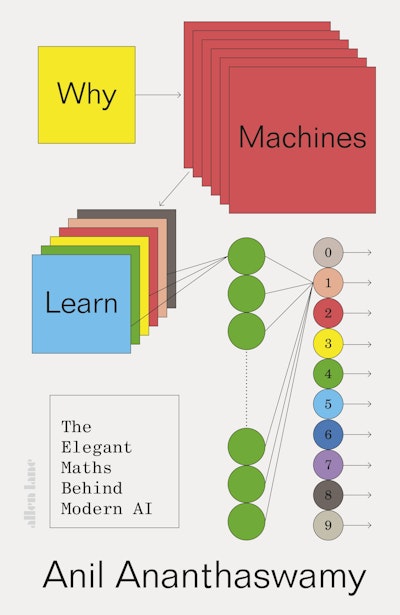- Published: 16 July 2024
- ISBN: 9781802060874
- Imprint: Penguin eBooks
- Format: EBook
- Pages: 496
Why Machines Learn
The Elegant Maths Behind Modern AI
- Published: 16 July 2024
- ISBN: 9781802060874
- Imprint: Penguin eBooks
- Format: EBook
- Pages: 496
After just a few minutes of reading Why Machines Learn, you’ll feel your own synaptic weights getting updated. By the end you will have achieved your own version of deep learning — with deep pleasure and insight along the way
Steven Strogatz
Anil Ananthaswamy’s Why Machines Learn embarks on an exhilarating journey through the origins of contemporary machine learning. With a captivating narrative, the book delves into the lives of influential figures driving the AI revolution while simultaneously exploring the intricate mathematical formalism that underpins it. As Anil traces the roots and unravels the mysteries of modern AI, he gently introduces the underlying mathematics, rendering the complex subject matter accessible and exciting for readers of all backgrounds
Björn Ommer
Some books about the development of neural networks describe the underlying mathematics while others describe the social history. This book presents the mathematics in the context of the social history. It is a masterpiece. The author is very good at explaining the mathematics in a way that makes it available to people with only a rudimentary knowledge of the field, but he is also a very good writer who brings the social history to life
Geoffrey Hinton
If you were looking for a way to make sense of the AI revolution that is well underway, look no further. With this comprehensive yet engaging book, Anil Ananthaswamy puts it all into context, from the origin of the idea and its governing equations to its potential to transform medicine, quantum physics—and virtually every aspect of our life. An essential read for understanding both the possibilities and limitations of artificial intelligence
Sabine Hossenfelder
Why Machines Learn is a masterful work that explains — in clear, accessible, and entertaining fashion — the mathematics underlying modern machine learning, along with the colorful history of the field and its pioneering researchers. As AI has increasingly profound impacts in our world, this book will be an invaluable companion for anyone who wants a deep understanding of what’s under the hood of these often inscrutable machines
Melanie Mitchell
Generative AI, with its foundations in machine learning, is as fundamental an advance as the creation of the microprocessor, the Internet, and the mobile phone. But almost no one, outside of a handful of specialists, understands how it works. Anil Ananthaswamy has removed the mystery by giving us a gentle, intuitive, and human-oriented introduction to the math that underpins this revolutionary development
Peter E. Hart
An entertaining journey… Ananthaswamy has the uncanny ability to answer questions with simple and illuminating examples just as they arise in the reader’s mind… Why Machines Learn demystifies the underlying mechanisms behind machine learning, which may possibly lead to a better understanding of the learning process itself and the development of improved AI
Physics World
A deep look at the mathematical innovations that made the AI revolution possible. One of the most useful books on AI that I've ever read!
Cal Newport





